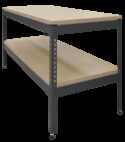Experiment
TE16
STIFFNESS - MATERIALS, STRUCTURES
A bench mounting 3-point bend apparatus to allow investigations into the stiffness in bending of different materials of the same cross-section (Young's Modulus - Stiffness) and the stiffness of a single material with different cross-section geometries (Second Moment of Area - 'I' Value).
If you have any questions or you'd like to discuss a product, please call us.
+44 1159 722 611STIFFNESS - MATERIALS, STRUCTURES
A compact, bench-mounting frame that holds different parts for investigations into stiffness of materials. The standard TE16 includes parts for tests in bending of beams of different materials and cross-section. Optional additional kits allow investigations into different beam fixings and torsional stiffness.
The main part is a rigid metal frame. Supplied as standard are two adjustable knife edges that work as simple supports for test beams. A linear scale on the back panel of the frame allows accurate positioning of the knife edges. The kit also includes weights, a magnetic dial gauge and a set of different beams. Also included in the standard TE16 kit is a vernier gauge for students to accurately measure dimensions of the specimens they test.
Students add different loads to the beams using weights on a hanger. The dial gauge indicator on the back panel accurately measures beam deflection.
The Additional Experimentation Kit (TE16a), available as an optional extra, enables further investigations into a simple cantilever, a propped cantilever and an encastre beam. The Additional Torsion Testing Kit (TE16b) is also available as an optional extra. It allows torsion tests on solid rods of different materials and a tube.
Learning outcomes
Standard TE16 Kit:
- Investigation of the stiffness in bending of different materials of the same cross-section (Young’s modulus/stiffness)
- Investigation of the stiffness of a single material with different cross-section geometries (second moment of area, or I value)
When used with the optional TE16a:
- Experiments to find the deflected shape of a beam and bending of a beam clamped at one end (a cantilever).
- Comparison of a simply supported beam, a cantilever and an encastre beam.
When used with the optional TE16b:
- Experiments to find the relationship between angular deflection and the dimensional and material properties of rods and tubes (torsional stiffness).












